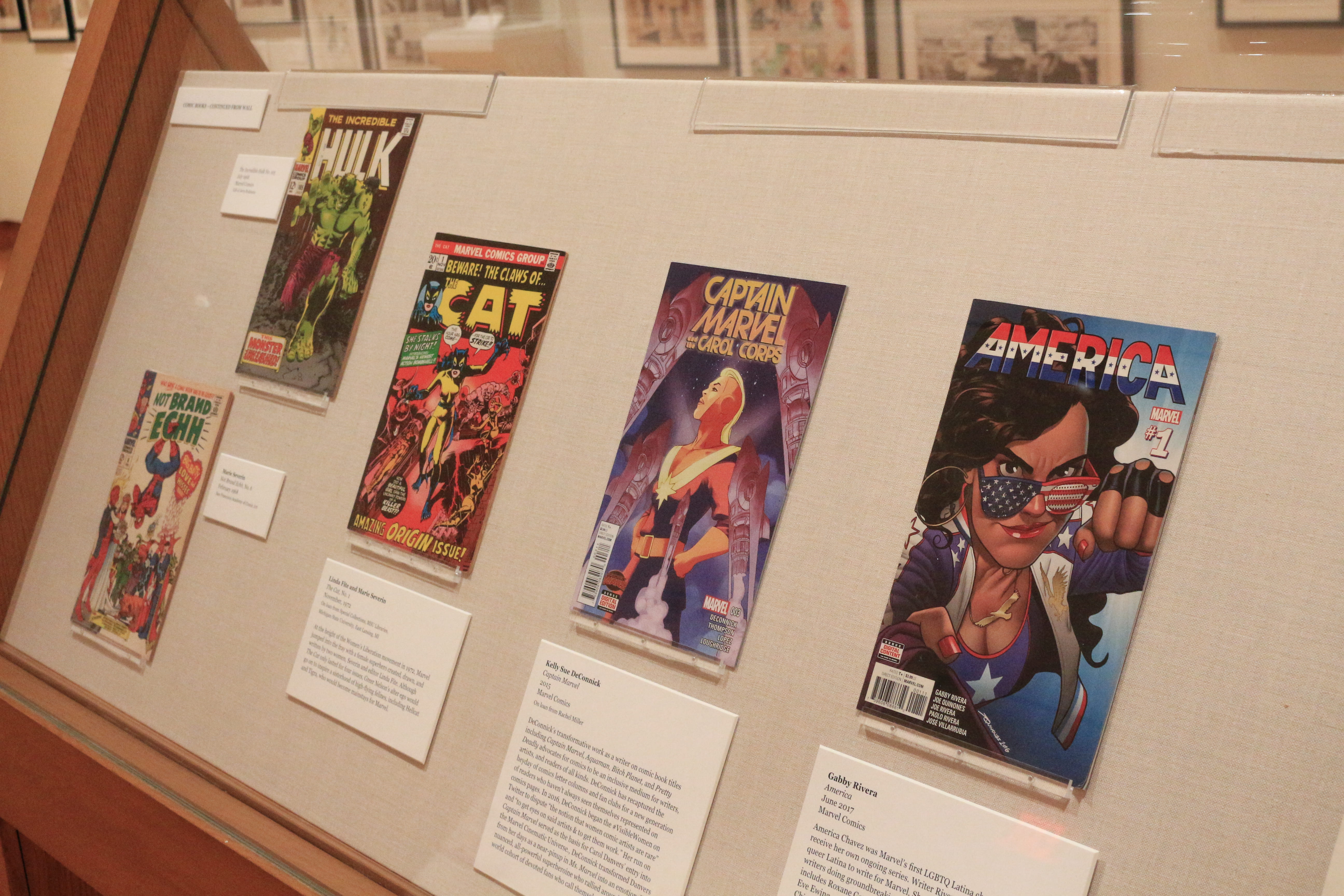
A series of superhero comics in the “Ladies First: A Century of Women’s Innovations in Comics and Cartoon Art” exhibit at the Billy Ireland Cartoon Museum and Library in Columbus, OH on Sunday, Mar. 21, 2021. Credit: Andrew Horne | Lantern Reporter
The influence of female cartoonists throughout history runs especially deep this March, as the Billy Ireland Cartoon Library and Museum celebrates Women’s History Month.
“Ladies First: A Century of Women’s Innovations in Comics and Cartoon Art” features hundreds of works by female cartoon artists that highlight their impact on social change, movements and culture in the 100 years since the passage of the 19th Amendment, which gave women the right to vote, Caitlin McGurk, associate curator at the Billy Ireland Cartoon Library and Museum, said.
“I think representation is extremely important,” McGurk said. “This exhibit is a great way to celebrate women’s history, as it specifically relates to this form, and to, discover new artists and new comics and graphic novels.”
Originally opened in November 2019, the exhibit was planned to coincide with the 100th anniversary of the 19th Amendment in 2020 but was instead delayed throughout much of 2020 due to the pandemic, Rachel Miller, an instructor of art history at Columbus College of Art and Design, said.
The exhibit, which is on display through April 18, aims to highlight the impacts and innovations of female artists throughout the last century of comics and cartoons along with featuring an inclusive and diverse roster of voices, McGurk said. The exhibition features a variety of cartoon mediums, ranging from magazine and political cartoons to graphic novels.
“We wanted to create an exhibit that wasn’t just like a survey of the various women who create comics because to us it’s a given that women create comics — it’s not a novelty,” McGurk said. “We focused on people who have been innovators, pushed the medium forward in different ways, or been key to certain movements throughout comics history.”
“Ladies First” begins by featuring female artists, painters and illustrators who worked to create political cartoons about the suffrage movement, McGurk said. Battling the negative stereotypes created by the male-dominated cartoon industry, female cartoonists worked to create an image of the suffrage movement that was more appealing towards women who were considering getting involved.
“These women would be depicted in really unflattering ways because … they didn’t want women to have the right to vote,” McGurk said. “When these women cartoonists got involved in the movement, they kind of rebranded the image of the suffragette into more of an everywoman.”
Artwork in the exhibit is pulled from a number of sources, including Billy Ireland’s own collection, which is one of the largest collections of comics in the world, Miller said. Additional artwork in the exhibit was borrowed from Michigan State University along with pieces from personal artists and collectors.
Included in “Ladies First” are the original art pieces by Jackie Ormes, the first Black woman to have a syndicated newspaper comic strip, Miller said. These featured pieces are the only known original pieces by Ormes.
McGurk said the images from Ormes’s magazine cartoon “Patty-Jo and Ginger,” featuring a teenage girl and her little sister, were licensed and used as the model for the first Black American Girl doll.
Additional pieces include original pages and research from Carol Tyler’s “The Hannah Story,” widely recognized as one of the best autobiographical comic stories ever written, and the “Captain Marvel” superhero comic by Kelly Sue DeConnick, Miller said.
Miller said the piece that might best represent the exhibition is the collection of cartoons from the underground comix movement, which began in the 1960s and 1970s and featured female artists who would freely write about their lives in a new way, such as in the Twisted Sisters collective.
“You have all these women who are working together to make their lives and their stories more visible, and that to me kind of captures the essence of the exhibit itself,” Miller said.
The Billy Ireland Cartoon Library and Museum, located at 1813 N. High St., is open from 1-5 p.m. on Saturdays and Sundays by appointment only. Visitors can schedule an appointment on the museum’s website.


